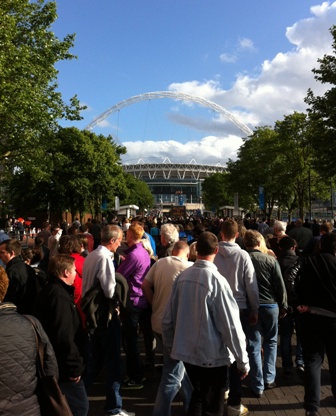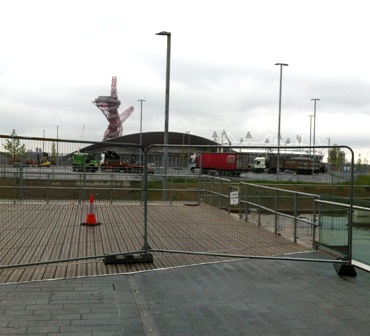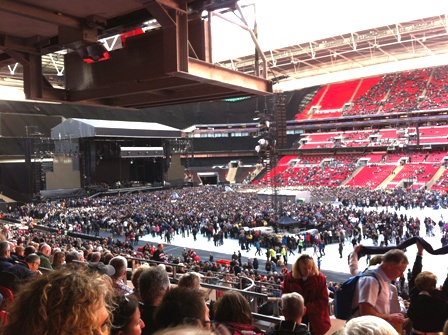
Wembley Way: E Street just for the day
Rocky ground: the tale of two cities, three stadiums and billions of pounds
When Bruce Springsteen’s Wrecking Ball tour reached London he became the unwitting protagonist in a tale of two cities, three stadiums and several billion pounds. Having been among the Springsteen faithful at Wembley Stadium, Jonathan Ives considers the fate of big buildings constructed on a grand scale.

Wembley Way: E Street just for the day
The Wrecking Ball tour pulls into town, rolls up its pants and takes a stab at delivering a personal and nuanced performance to tens of thousands of people every night. And it does a pretty good job, particularly when one considers that this is rock and roll on an industrial scale, a man and his band at one with their audience in a venue primarily designed for sporting spectaculars that aspire to global significance.
Sitting in a stadium high above a football pitch that is filled with thousands of people watching a concert, The Leisure Review cannot help but reflect on a facility-related theme emerging from the evening’s event. The title track of Springsteen’s new album and the song that gives the tour its name, Wrecking Ball, is a memorial to the Giants Stadium in New Jersey. Wembley Stadium, in which we have taken our seats, is the first port of call for Springsteen’s E Street Band on this visit to the UK. A couple of weeks later Springsteen is scheduled to perform as the headline act at a day-long event at what we are now invited to call the Queen Elizabeth Olympic Park. As a brief whistle-stop tour of modern stadium development, it seems hard to beat.
Before the wrecking ball arrived the Giants Stadium was part of the Meadowlands sports complex in Springsteen’s home state of New Jersey. Among America’s most famous sporting stadiums, it was also one of the venues at which the Springsteen legend was forged and honed. In Wrecking Ball, the song, the Giants Stadium is used as an emblem of strength, part of a parable of faith and defiance in the faith of adversity and overwhelming odds: “I was raised outta steel/ Here in the swamps of Jersey/ Some misty years ago”.
If the resilience and rebirth of the spirit of ordinary people are among the most enduring and most powerful themes of Springsteen’s work, it is rare in his extensive body of work that buildings are invested with such significance; people’s homes, perhaps but not a sports venue. If the song suggests what an impact the Giants Stadium, now replaced by the adjacent New Meadowlands Stadium (itself quickly rebranded as the MetLife Stadium after the sale of the naming rights) must have made on Springsteen, it also serves to illustrate the scale of the challenge when building modern sports venues. This is big business, a rigorously unsentimental pursuit in which a single function will no longer justify the enormous investment required.
Opened in 1976, the Giants Stadium was unique in the National Football League in that a single stadium was home to two teams, the New York Giants and the New York Jets. With more than 80,000 seats, by the time the bulldozers moved in the stadium had been host to pro and college football games, a soccer World Cup, out-of-season tours by European soccer teams, countless bands and at least one pope. The new stadium was constructed immediately adjacent to the old stadium, enabling the New Meadowlands Stadium to open just a few months after the old Giants Stadium was reduced to rubble.
Built jointly by the Giants and the Jets with private funding, the new stadium is reported to have cost some $1.6 billion. At the time, and perhaps still, regarded as one of the most expensive stadiums ever built, a cynic might be tempted to note that ongoing financial arguments meant that this supposed state-of-the-art stadium does not have a roof, a facility that was finally deemed beyond the means of the budget available. It does have 82,500 seats and a neat system that allows the stadium to be reconfigured as the home venue of each of its tenants: end-zone pitch emblems are swapped as appropriate and the exterior of the building is lit in appropriate colours so that the stadium is seen to change colour to match the tastes of each franchise.
Wembley Stadium was similarly a celebrated venue that was reimagined and reinvented as a modern entertainment complex. As with the replacement for the Giants Stadium, the demands of multiple sports were, initially at least, central to the funding arrangements of a new national stadium but disagreements over funding meant compromise on the preferred design. Eventually the reinvention of Wembley Stadium was partial, the interested parties settling for a stadium designed specifically for football, along with other similarly pitch-based sports, and the demands of the modern mega-concert circuit.
Visiting Wembley for a major event, the most obvious question – what did we get for the best part of £800 million – is inescapable. While some lament the disappearance of the Twin Towers (at The Leisure Review we prefer to wonder what happened to the ceramic relief commemorating the all the winners of events at the 1948 Olympic Games), there is no doubt that you get a pretty impressive stadium for your money. However, it seems that the answer to the question is, in the manner of a curate tackling an unpleasant meal in trying circumstances, dependent upon the point in the experience at which the question is asked.
Having arrived in Wembley by tube, the ticket-holder is swiftly and efficiently directed up Wembley Way, a broad pedestrian boulevard, towards the stadium. Roof-supporting responsibilities notwithstanding, the stadium arch fulfils its main task of making a distinctive visual impact while also making the direction of travel sufficiently obvious for even the most directionless visitor and around the stadium’s concourse there seems to be plenty of room for wandering and browsing, although the presence of rows of temporary chemical toilets suggests that the boast that Wembley has more toilets (2,618 apparently) than any other building in the world is not quite as impressive as one might have thought. There are plenty of turnstiles to prevent lengthy queues and inside the stadium one is immediately struck by the vertiginous stands that rise straight from pitchside to dizzying heights. They provide covered seating for 90,000 people during a match or in excess of 70,000 in concert mode, some of whom – those standing on the pitch area -- might get a bit wet. In marked contrast to the old Wembley, there is just enough room to take one’s seat in reasonable comfort and the other essential facilities – toilets and bars – are plentiful and accessible (it should be noted that our all-male party of two was unable to vouch for the efficacy of the women’s toileting facilities, which remain a notorious source of irritation for female visitors to almost every entertainment venue ever built). From your seat it is also noticeable that those on the pitch have plenty of access/exit points via which to access the stadium’s essential facilities, in marked contrast to the old Wembley and even new venues offering themselves as concert venues, such as Arsenal’s Emirates Stadium.
The downsides of Wembley Stadium as a venue are generally those beyond the control of stadium architects. Going to see a band perform in a football stadium is a daft idea at the best of times and usually a triumph of hope over experience for the concert-goer. Invariably the majority of the audience is too far from the stage to see anything other than the big screens, the sound is poor for anyone not stood in front of the mixing desk and at every turn you cannot help but be reminded that this is a venue designed for watching football. However, a performer with the charisma and the stadium experience of Springsteen is well able to deliver a memorable event even if the circumstances are unpromising and there is something life-affirming about being part of such grand-scale events.
That it is a football stadium is, of course, not really Wembley’s fault. The most obvious negative is that Wembley Stadium is in Wembley, a suburb of London that is a bit of a pain to get to from London, never mind anywhere else. It is also a suburb of London that is adequately served by the capital’s public transport system if one happens to be travelling on a weekday afternoon when not much else is happening. Getting to and, more pertinently, from a major event is always something of a chore wherever it is but at least facilities at Wembley’s main tube station are much improved and the management of the crowd moving en masse towards the station is good-natured and effective, a marked improvement to the frightening free-for-all of a decade ago.
Such are the minor trials of attending a mass event and generally people are able to be part of the process with good humour if given sufficient information, a reasonable expectation of efficient transport and a management team with the experience to manage such a difficult environment. The London 2012 Olympic Games certainly demonstrated this to good effect and no doubt those who went along to the Olympic Park a couple of weeks after the Wembley gig to see Springsteen headline the Hard Rock Calling event would have cause to remember the stewards as one the highlights of last year’s remarkable summer.
Reports suggest that Springsteen once again delivered a barn-storming three-hour-plus set to send everyone home with their expectations surpassed but memories of the Olympic Stadium will not have been part of the deal. This gig took place not in the stadium but in the Olympic Park’s entertainment area, a section of the park situated between the looming uncertainty of the stadium and the confident futurism of the velodrome. Anxious to show that the Olympic Park has been used for something other than barricades and construction in the ten months since it entered “legacy mode”, the park’s authorities were no doubt relieved to see someone on the site not wearing hi-vis clothing but if they are looking for positive legacy stories they may have to think again. While the crowd was appreciative of Springsteen’s efforts, it seems that few were enamoured with the Olympic Park. The Independent’s reviewer summed it up: “Sadly the dusty and stone-filled venue failed to live up to the rose-tinted Olympic memories of the site and even the £600,000 ‘easigrass’ surface (basically a fake lawn) failed to stop the place feeling like a bit of building site.”
Springsteen will probably not have minded playing in the shadow of the Olympic Stadium rather than in the stadium itself but he may just have had a moment to wonder why it was good enough for Bolt but not the Boss. With such a glorious Olympic summer made winter by legacy discontent, it seems that the centrepiece of London 2012 still has a long way to go before fulfilling any of the varied and conflicting ambitions for its future outlined in countless meetings and innumerable documents. That the future of this Olympic stadium, clearly outlined and specified in the design brief from the outset, is still the subject of argument, debate and litigation speaks volumes for the challenges of modern stadium management and the funding structures that exist to make them possible.
But at least in the UK we are not alone. The New Meadowlands Stadium should have had a roof and the tenancy agreements to keep the stadium’s tenants in place in the face of uncertainty and competition from other locations are said to be Byzantine in their complexity. At least we have some venues that can offer a home, however temporary, to the E Street Band. In these troubled times that may have to be enough.
Jonathan Ives is the editor of The Leisure Review.
The Leisure Review, August 2013
© Copyright of all material on this site is retained by The Leisure Review or the individual contributors where stated. Contact The Leisure Review for details.
![]() Download a pdf version of this article for printing
Download a pdf version of this article for printing

The Olympic Stadium: the view most familiar to most recent visitors

Wembley Stadium: getting ready to hear some music